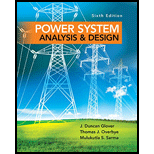
Concept explainers
(a) Transform
Want to see the full answer?
Check out a sample textbook solution
Chapter 2 Solutions
Power System Analysis and Design (MindTap Course List)
- The voltage across the terminals of the 5μF capacitor is 30 cos (4000t + 25°) V. Calculate (a) the capacitive reactance; (b) the impedance of the capacitor; (c) the phasor current I; and (d) the steady-state expression for i (t). 5 μF + v iarrow_forwardA 25V, 2.5kHz supply is connected to a network comprising a variable capacitor in parallel with a coil of resistance 250 ohms and inductance 80 mH. Determine, for the condition when the supply current is a minimum the capacitance of the capacitor the dynamic impedance the supply current the upper half-power frequency the value of the circuit impedance at the -3dB frequenciesarrow_forwardIn the series circuit of Fig, the source has voltage amplitude 20.0 V and angular frequency 5.40 x 103 rad/s, the inductance is 6.50 mH, the capacitance is 0.600 µF, and the impedance is 474 Ω. Find (a) the resistance, (b) the current amplitude, (c) the resistor voltage amplitude, (d) the inductor voltage amplitude, and (e) the capacitor voltage amplitudearrow_forward
- The phasor current Ib in the circuit is 25 0 . mA.1. Find Ia, Ic, and Ig.2. If ω=1500 rad/s, write expressions for ia(t), ic(t), and ig(t).arrow_forwardGiven the following pairs of voltages and currents, indicate whether the element involved is a capacitor, an inductor, or a resistor, and determine the values of C, L or R where ω= 157 rad/s a. v = 2000 sin ωt ; i = 5 cos ωt b. v = 80 sin(157t + 150°); i = 2 sin( 157t + 60°) c. v = 35 sin(ωt − 20°); i = 7 cos( ?? − 110°)arrow_forwardThe current in an L-R-C series circuit has amplitude 0.120 Aand angular frequency 8.00 * 103 rad/s, and it has its maximum positivevalue at t = 0. The resistance is 95.0 Ω, the inductance is 6.50 mH,and the capacitance is 0.440 mF. For the resistor, inductor, and capacitor,find (a) the voltage amplitudes and (b) the instantaneous voltages att = 0.305 ms.arrow_forward
- Assume that the voltage drop across the resistor, ER, is 78 V, that the voltage drop across the inductor, EL, is 104 V, and the circuit has a total impedance, Z, of 20 . The frequency of the AC voltage is 60 Hz. ETITZ20VAPFER78VIRRPEL104VILXLVARsLLarrow_forwardCOURSE: Electrical EngineeringSUBJECT: Electrical ApparatusINSTRUCTIONS:• Write the GIVEN with their respective symbols and units.• Do not skip the SOLUTIONS, do it step-by-step with their respective symbols and units• Round up to 3 three decimal places the FINAL ANSWERS and BOX it. PROBLEM:A capacitor in series with a 66 Ω resistor is connected to a 120 V, 60 Hz source. If the impedance of the circuit is 116 Ω, determine the size of the capacitor.arrow_forwardFor the circuit shown below, the switch is initially open and is closed at t = 0. The component values are given by R = 1 Ω, C = 1/8 F and L = 1/2 H. A generator voltage is expressed by vg(t) = 2sin 4t[V].a)Determine the equivalent impedance to the right of points a and b of the circuit, Z(s).b)Determine the expression for the input current of the circuit i(t).c)Calculate the expression for the output voltage of the circuit vo(t).arrow_forward
- A resistor'R' with resistance value of 24 ohm, an inductor 'L' with inductance 20mH, and a capacitor 'C' with capacitance 50 micro Farrad are connected in series with a AC voltage v(t) where v(t) = 50 cos (2 vt + 30 degrees) v. Determine the current i(t) and total impedance if the frequency f is i. 60 Hz ii. 400Hzarrow_forwardA transmission line has the following primary constants: resistance R = 15 /loop km, inductance L = 3.4 mH/loop km, conductance G = 3µS/km and capacitance C = 10 nF/km. Determine the characteristic impedance of the line when the frequency is 2 kHzarrow_forwardDISCRETE TIME GIVEN SYSTEM.Determine the poles and zeros of this system, and show how they relate to each other.The system is only marginally stable True False Find the frequency response of this system. ( NEED NEAT HANDWRITTEN SOLUTION ONLY OTHERWISE DOWNVOTE).arrow_forward
 Delmar's Standard Textbook Of ElectricityElectrical EngineeringISBN:9781337900348Author:Stephen L. HermanPublisher:Cengage Learning
Delmar's Standard Textbook Of ElectricityElectrical EngineeringISBN:9781337900348Author:Stephen L. HermanPublisher:Cengage Learning
